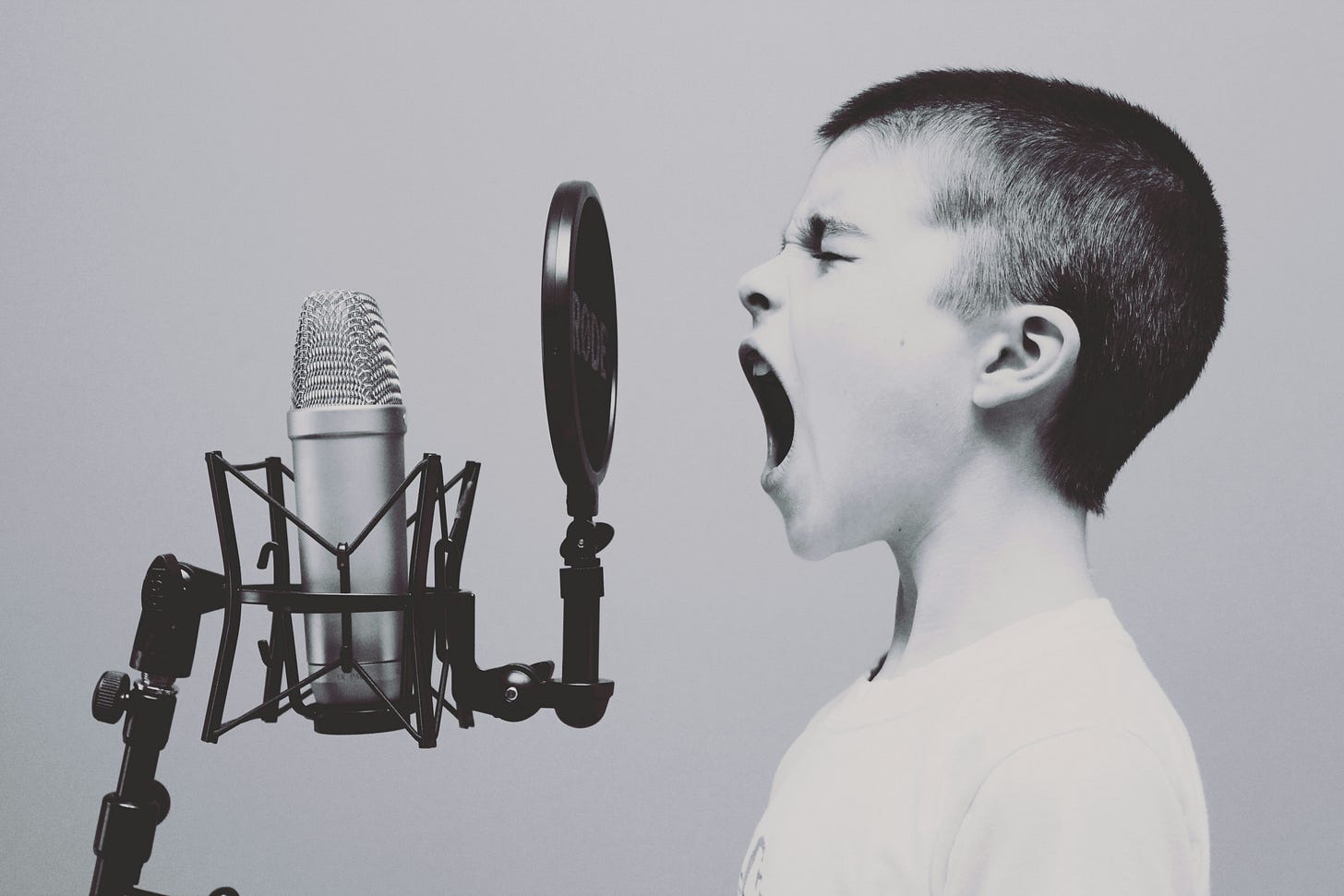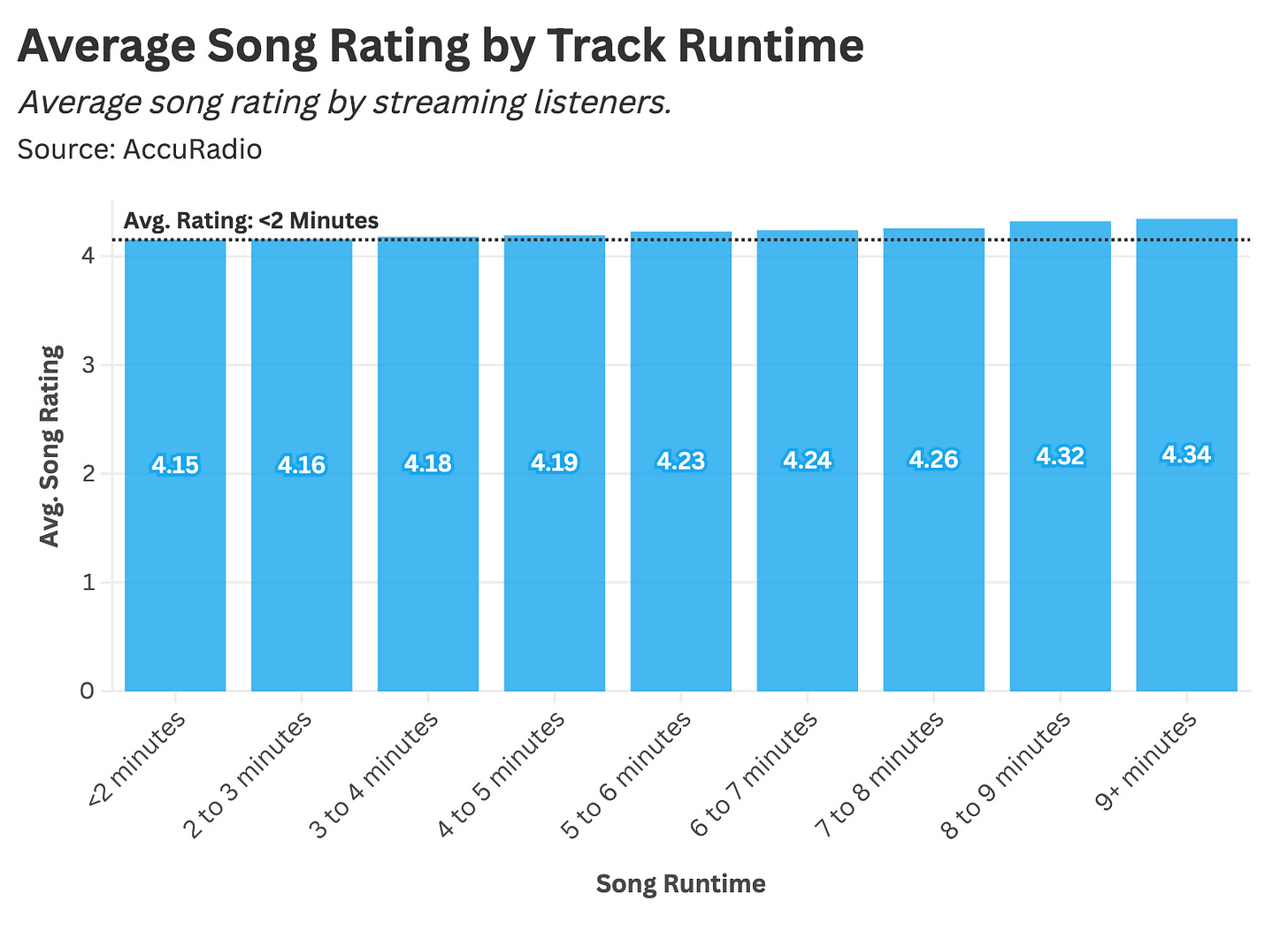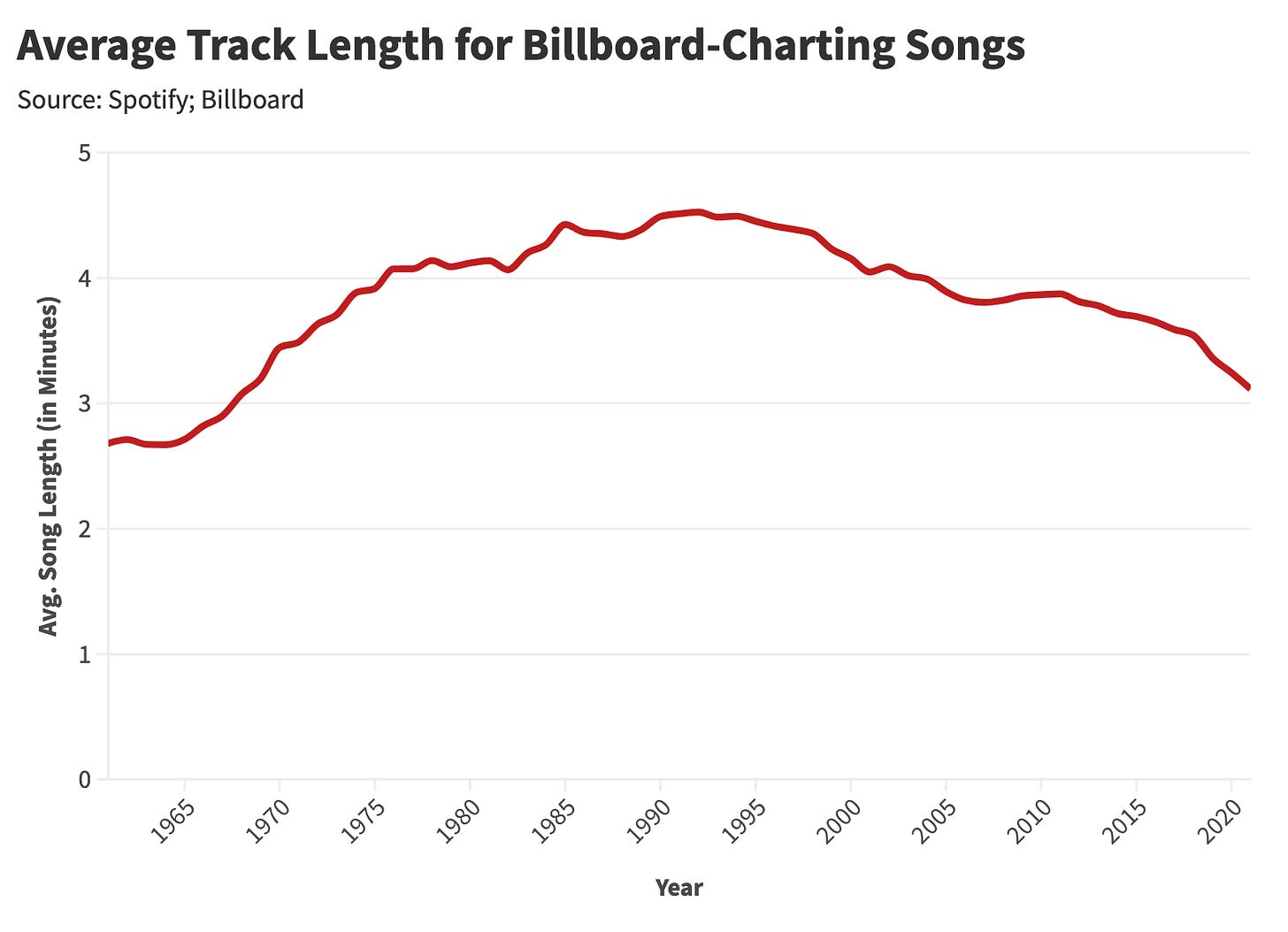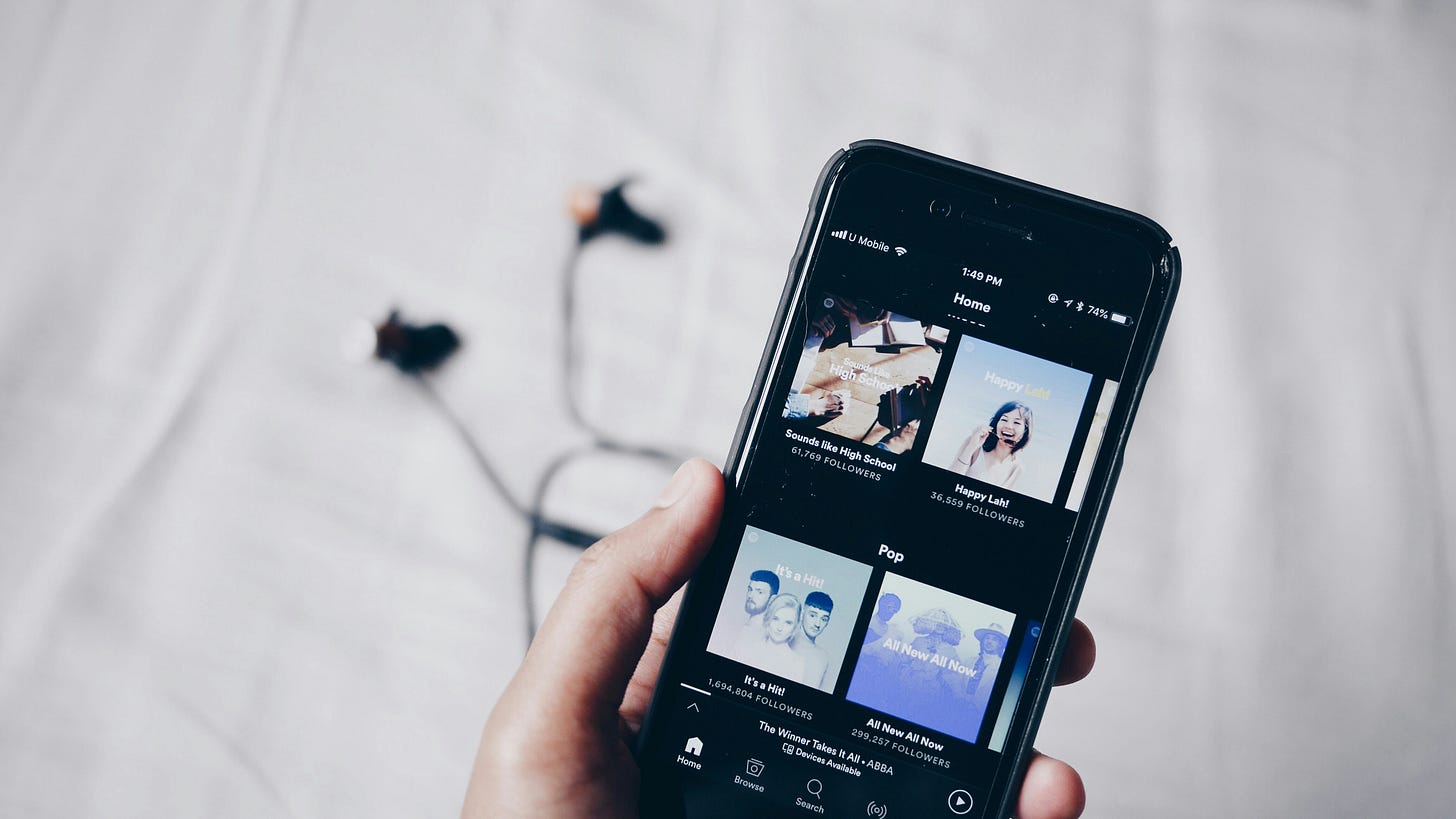What's the Perfect Song Length? A Statistical Analysis
Investigating the "ideal" song length, and whether such a thing exists.

Intro: When Does The Average Listener Lose Interest?
The 2024 box office bomb Here—a Tom Hanks melodrama that takes place in one room—is a bad movie with a surprisingly good trailer. The trailer was so compelling that I rushed home to hear a song that soundtracked this preview. I can't remember the last time I discovered music in the wild, so I was rather excited.
Listening to this track in its entirety was an emotional rollercoaster:
After Minute 1: I had found my next great song. I was a person capable of discovering new music—no longer a stunted cultural dinosaur approaching middle age.
After Minute 3: This song was still great, but I was unsure how this band was going to land the plane. Maybe the music would simply fade out. 🤷♂️
After Minute 5: The song was still going, for whatever reason. At this point, the musicians were just making random noises. 🙃
After Minute 6: I had completely lost interest.
After 7 Full Minutes: The song finally ended, and I was back where I started—a stunted cultural dinosaur approaching middle age.
I'm convinced this tune would be a masterpiece if it ended after three minutes and fifteen seconds—a decidedly hot take that got me thinking about the ideal song length. Does such a thing exist? Can we pinpoint a threshold after which the average listener loses interest, or is this topic simply too nuanced for a one-size-fits-all answer?
So today, we'll try to pinpoint the ideal song length, examine how this hypothetical varies by genre, and analyze recent trends in popular music runtimes.
What's the Perfect Song Length?
AccuRadio is a free, human-curated internet radio service that offers over 1,000 customizable music channels. The site logs over 1.8 billion global trackplays per year and has decades' worth of data on listener behavior.
AccuRadio allows its users to rate songs on a scale of 1 to 5. A "5" means you will hear a lot more of that song, and a "1" or "2" means that track is effectively banned from future listening sessions.
So, how do AccuRadio user ratings change as a function of track runtimes? Well, counterintuitively, listener acclaim improves as song duration increases.
Does this mean the answer to "what's the ideal song length" is simply "as long as possible"? Surely, a limit must exist.
Perhaps this trend is a product of self-selection: listeners who dislike extended runtimes skip longer songs and, therefore, never rate a 7-minute track. As such, we'll need to analyze:
Those who listen and rate songs (which we've already done)
Those who do not finish a track
To examine the latter, we'll measure user "skip" percentage as a function of track duration.
This trend is even more counterintuitive: people are more likely to skip songs that run three to five minutes than a track that lasts seven minutes.
How is this possible? I thought this analysis was going to be straightforward: I run one query, get a simple answer—something like four minutes—and move on with minimal follow-through. Yet the interplay between song duration and listener preference is decidedly complex, meaning there's no "golden" number—just like most things in life.
Ideal track length—if such a thing exists—is shaped by myriad factors, including genre conventions, audience expectation, age, and the realities of digital discovery in a streaming-dominated landscape.
Enjoying the article thus far and want more data-centric pop culture content?
What's the Perfect Song Length? Part 2: Investigating Genre, Age, and Changing Norms
Running just over eight minutes, "The Prophet's Song" is Queen's longest studio track, appearing as the seventh title on their album "A Night at the Opera." During the heydey of CDs, cassettes, and vinyl, listeners averse to the song's eight-minute runtime had no choice but to skip this track. In today's world of algorithmic recommendations and hand-crafted playlists, the song's lengthy runtime is punished through lack of exposure. People can simply avoid this tune altogether, which means the track sees fewer plays, appears on fewer playlists, and is rendered obscure relative to Queen's other works. While this phenomenon does not affect every long-running song, it disproportionately penalizes grander compositions that lack a committed fanbase.
Nearly 90% of streaming activity converges on tracks lasting between two and five minutes.
Overall, the pool of long-running songs is small, and they don't draw substantial listenership—at least in aggregate. Yet this 3,000-foot view obscures the idiosyncratic nature of listener preference.
Track duration is heavily influenced by genre conventions, with most musicians adhering to the norms established by their peers and predecessors. Long-running songs—which we'll define as any tune exceeding seven minutes—are relatively scarce outside specific genres.
Instrumental formats such as classical and jazz favor lengthier compositions, as do guitar-driven styles like rock and metal.
Devoted fans of these genres are disproportionately responsible for the high ratings and low skip percentages observed for longer-running tracks. A nine-minute song does not deter these listeners; in fact, it's precisely what they expect from Beethoven's "Symphony No. 6," Led Zeppelin's "Stairway to Heaven," or Miles Davis' "So What." Here, we actually see self-selection in action since listeners drawn to longer runtimes are more likely to be matched with these tracks. Optimal song matching is a principal benefit of music streaming and algorithmic curation—a feature, not a bug—though I know using the words "algorithm," "streaming," and "benefit" in the same sentence is heresy (Spotify bad!!! Boo streaming!!!).
Meanwhile, pop and hip-hop—two genres that dominate contemporary music—tend toward shorter runtimes. With the decline of rock and the rise of shorter song formats, the once-beloved "toilet track" has become a thing of the past. What's a toilet track, you ask?
In radio parlance, a "toilet track" is a longer-than-usual song that allows a DJ to go to the bathroom. In 2022, Jacobs Media polled several radio personalities to identify the greatest "bathroom break" songs of all time. The top five songs highlighted were:
Peter Frampton's live version of "Do You Feel Like We Do"
"American Pie" by Don McLean
“Free Bird” by Lynyrd Skynyrd
"Stairway to Heaven" by Led Zeppelin
"In-A-Gadda-Da-Vida" by Iron Butterfly
The commonality amongst these classics is that they were all released in the late 1960s and early 1970s when rock dominated popular music.
Unfortunately, radio DJs may struggle to find a "toilet-worthy" tune released in the last decade. Since the late 1990s, the average duration of Billboard-charting songs has consistently declined.
If an "ideal" song length does exist, it evolves with each era's prevailing musical style.
This 30-year decline in average song duration can be traced to three paradigmatic shifts in music economics and taste. First, we have the death of rock and the end of long-running tracks with extended guitar solos. Second, the arrival of iTunes and the rise of streaming platforms led to a decoupling of songs and albums. Artists began focusing on the commercial maximization of individual tracks over cohesive album concepts. Third, streaming services moved the industry toward a pay-per-play revenue model, rewarding artists for the number of listens instead of total listening time. Streaming ten 31-second tracks pays more than a single stream of a 310-second song.
The recent decline in average track duration has also been accompanied by a sustained dip in the variability of Billboard-charting song lengths. Said differently, popular music (mostly) falls within a narrowing range of ever-shortening runtimes.
Somehow, limitless cloud storage and infinite streaming selection have yielded a runtime uniformity comparable to the 1950s and the days of 78 RPM records. How silly.
Tracing the historical progression of popular music runtimes brings us to our final explanatory factor for "ideal" song duration: listener age.
Overall, younger listeners prefer shorter tracks, while those ages 30 to 70 prefer longer runtimes. Interestingly, average track length drops again among listeners over 70, falling below that of middle-aged cohorts.
These runtime preferences can be explained by my *grand unifying theory of music listenership*: in short, we gravitate toward the music of our adolescence.
A 2021 New York Times analysis of Spotify data revealed that our most-played songs often stem from our teenage years, particularly between the ages of 13 and 16.
How does this phenomenon influence ideal song duration? Well, listeners under 30 and above 70 likely favor shorter tracks that shaped their teenage years, while those between 30 and 70 prefer longer-running classics popular in the 1970s, 1980s, and 1990s.
The naively simple question of "optimal" song length has an even simpler answer: "It depends." Our preferred track runtime is driven by a mix of formative musical experiences, the machinations of popular culture, and genre preferences:
If you grew up on "Free Bird," Stairway to Heaven," and DJ toilet tracks, your platonic ideal might entail a longer runtime.
If you enjoy Miles Davis, Kenny G, or Beethoven (an admittedly eclectic trio of instrumental musicians), you might also favor longer track lengths.
If your childhood was defined by Roy Orbison and Nat King Cole pop standards on 78 RPM records, you might prefer a crisp two-minute track.
If you're a teenager today, chances are you prefer shorter songs—and you'll inevitably be told it's because your generation has a short attention span. But it's not your fault; you're simply living in an era where song lengths are shrinking and variety is scarce.
Final Thoughts: The "McDonald-ization" of Song Lengths
As a freshman film major, I took a course called "Analyzing Cultural Contexts." Because I was a freshman with a poor work ethic, I did not pay attention during this class (as is my right as an American! 🇺🇸). As a full-fledged adult professional who writes about culture, I wish I had applied myself during this course.
I do, however, remember one lecture concerning the homogenization of culture—which the professor snidely referred to as the "McDonald-ization" of art. According to this lecture (and my subsequent Google research), cultural homogenization entails the emergence of a uniform global culture in place of local customs—driven by technological advances and globalization. Now, I know what you're thinking: you didn't sign up for some liberal arts lecture—you want to know about music and data.
So, how does all of this relate to ideal song runtimes? Well, consider this thought experiment: somehow, you are transported back to 1700s Vienna, then the music capital of the world, home to Amadeus Mozart. After deciding that you are not a space alien, the people of Vienna investigate your Spotify playlists and are shocked to see that nearly all songs run between two and five minutes. Your music is both short and uniform in duration relative to Beethoven's "Symphony No. 6" and Mozart's "Violin Concerto No. 3." According to these 18th-century folk (who have somehow mastered the iPhone), your songs are confined to a strict range of runtimes, inconsistent with their diverse spectrum of composition lengths.
If there is an ideal duration for popular music—and this is a big "if"—it falls within today's narrowing range of contemporary song lengths.
Over the last century, popular music runtimes have become increasingly standardized. Anything below two minutes is too short; anything above five minutes may be too long. This process of homogenization is driven by market forces—mainly, musicians worldwide are rewarded for tunes that fall within this accepted range (and are given less money when they ignore market demands).
If a track runs longer than six minutes, it inevitably begs the question of why. What's so special about these extra two or three minutes?
Two of my all-time favorite songs, LCD Soundsystem's "All My Friends" and Bruce Springsteen's "Rosalita," run longer than seven minutes and, in my heavily biased opinion, benefit from the epic scope provided by their runtimes. Though I hate to admit it, my fondness for these longer songs is a one-off. The extra two minutes of music is worth the emotional pay-off—though that's not always the case.
I realize it's rather callous to reduce music's value to a time optimization problem. Yet, cultural norms skew so heavily toward two-to-five-minute songs that anything beyond this range is easily identified and critiqued.
Our cultural reference points are a product of nurture, learned through the ubiquity of "McDonald-ized" music. When 90% of popular songs follow the same pattern, we naturally assume that's how music should be. As such, our perception of ideal song length is emblematic of our environment—more specifically, your environment when you were fifteen years old and extremely hormonal.
Struggling With a Data Problem? Stat Significant Can Help!
Having trouble extracting insights from your data? Need assistance on a data or research project? Well, you’re in luck because Stat Significant offers data consulting services and can help with:
Insights: Unlock actionable insights from your data with customized analyses that drive strategic growth and help you make informed decisions.
Dashboard-Building: Transform your data into clear, compelling dashboards that deliver real-time insights.
Data Architecture: Make your existing data usable through extraction, cleaning, transformation, and the creation of data pipelines.
Want to chat? Drop me an email at daniel@statsignificant.com, connect with me on LinkedIn, reply to this email, or book a free data consultation at the link below.
Want to chat about data and statistics? Have an interesting data project? Looking to produce data-centric editorial content? Email daniel@statsignificant.com












Love your work. Makes me wish I could code - that's powerful!!! At the risk of giving you an 18 minute chore, a couple of my favorite long songs are "Hey" by Low and "Donnie Darko" by Let's Eat Grandma. Enjoy, or don't!
Telegraph Road by Dire Straits. Under headphones (not ear buds....ugh!) You were right on about the age of acquiring musical tastes....mid teen years.